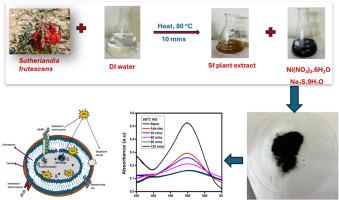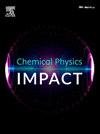Effect of calcination temperature on the structural and photocatalytic properties of nickel sulfide nanoparticles for dye degradation and antibacterial applications
IF 4.3
Q2 CHEMISTRY, PHYSICAL
引用次数: 0
Abstract
The need for multipurpose materials that are capable of degrading dyes and microorganisms is highlighted by the increasing numbers of pollutants contaminating water. This study examines the structural, optical, photocatalytic, and antibacterial characteristics of nickel sulfide (NiS) nanoparticles synthesised with the extract of Sutherlandia frutescens. NiS nanoparticles were synthesized at various calcination temperatures (uncalcined, 300 °C, 500 °C, and 700 °C) and analysed through XRD, FTIR, UV–VIS, BET, TGA, and SEM techniques. FTIR results verified the presence of functional groups derived from the plant extract, with clear peaks confirming the successful formation of nanoparticles, while calcination contributed to eliminating organic residues in some samples. XRD patterns revealed a hexagonal phase of α-NiS with crystallite sizes ranging from 15 nm to 28 nm, depending on calcination temperature. SEM images showed irregular, grain-like morphologies, with higher calcination temperatures resulting in larger and more aggregated particles. Photocatalytic experiments revealed that the material calcined at 300 °C achieved the highest degradation efficiency of Congo red dye (70 %) under UV radiation. Antibacterial assessments showed different inhibition zones against B. subtilis, K. pneumoniae, S. aureus, and Escherichia coli, with NiS synthesized at 300 °C displaying the most potent activity. Trapping experiments verified that holes (h⁺) served as the predominant active species in the photocatalytic reaction. These findings emphasise the potential of green-synthesized NiS nanoparticles as efficient and environmentally friendly materials for wastewater treatment and antibacterial applications.

煅烧温度对硫化镍纳米颗粒结构和光催化性能的影响
越来越多的污染水体的污染物凸显了对能够降解染料和微生物的多用途材料的需求。本研究考察了用Sutherlandia frutescens提取物合成的硫化镍纳米颗粒的结构、光学、光催化和抗菌特性。在不同的煅烧温度(未煅烧、300℃、500℃和700℃)下合成了NiS纳米颗粒,并通过XRD、FTIR、UV-VIS、BET、TGA和SEM等技术对其进行了分析。FTIR结果证实了来自植物提取物的官能团的存在,清晰的峰证实了纳米颗粒的成功形成,而煅烧有助于消除一些样品中的有机残留物。XRD谱图显示α-NiS为六方相,晶粒尺寸随煅烧温度的变化在15 ~ 28 nm之间。SEM图像显示出不规则的颗粒状形貌,煅烧温度越高,颗粒越大,聚集程度越高。光催化实验表明,在300°C下煅烧的材料在紫外辐射下对刚果红染料的降解效率最高(70%)。对枯草芽孢杆菌、肺炎克雷伯菌、金黄色葡萄球菌和大肠杆菌有不同的抑菌区,其中在300℃合成的NiS抑菌活性最强。捕获实验证实了h +是光催化反应中的主要活性物质。这些发现强调了绿色合成的NiS纳米颗粒作为废水处理和抗菌应用的高效和环保材料的潜力。
本文章由计算机程序翻译,如有差异,请以英文原文为准。
求助全文
约1分钟内获得全文
求助全文
来源期刊

Chemical Physics Impact
Materials Science-Materials Science (miscellaneous)
CiteScore
2.60
自引率
0.00%
发文量
65
审稿时长
46 days
 求助内容:
求助内容: 应助结果提醒方式:
应助结果提醒方式:


